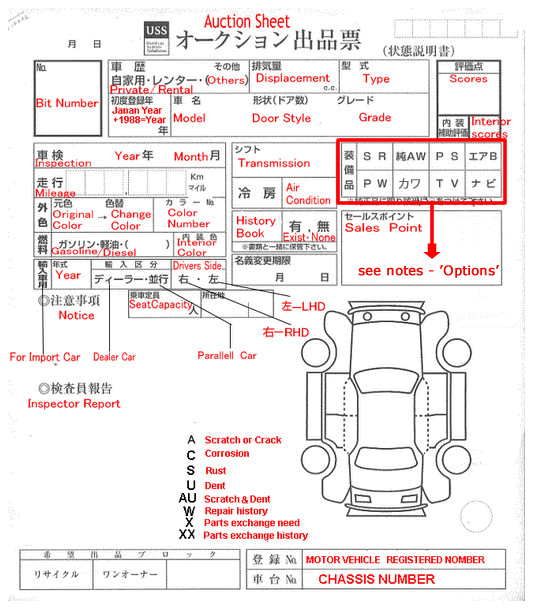09/08/2021
How to Read the Japanese Car Auction Sheet Properly
It goes without saying, if you want to buy a used vehicle, then getting it mechanically inspected is crucial. But what if the used vehicle you wish to buy is somewhere overseas?
Well, if you are thinking to import used vehicles from Japan and aren't sure how to test them first-hand, then this blog is here to help.
One of the easy ways to review the pre-used vehicle purchased at the Japan car auction is, of course, by inspecting the auction sheet. Sounds easy, right? Well, that is where the problem comes in. Unless you know how to read Japanese characters easily, you will have a stumbling block ahead.
But thankfully, Japanese auction sheets aren't that hard to read. All you need is a little translation guide to get started.
In this blog, we will try our best to cover all the basic information the auction sheet has to offer, but before that, let's understand –
What Is the Japanese Car Auction Sheet?
If you decide to buy a car from the Japan auction, you will require going through an auction sheet to determine the quality of the vehicle.
This sheet is created after a full mechanical inspection conducted by the professional inspectors hired by the auction houses.
What Does the Auction Sheet Contain?

Production Month and Year:
The exact year and month when the vehicle was manufactured so the buyer can calculate the proper age of the vehicle.
Lot Number:
Every used car is grouped into different lots. Lot number makes it possible to clearly identify and locate the vehicle from the largest selection.
Engine Displacement:
Offers details about the engine size.
Car Type:
Provides exact data on vehicle make and model.
Chassis Code:
Every vehicle manufactured in Japan has a unique chassis code.
Chassis Number:
This number can be used to verify the authenticity of the vehicle. For instance, you can use a chassis number to determine if the same vehicle was shipped as shown online or not.
Comments:
This is written by seller/inspector in Japanese characters. You can use google translate to understand the comments.
Additional Features:
Here, you will know about the AC system, transmission type of the vehicle, etc.
Additional Accessories:
This section will inform about any additional features of the vehicle. For instance, PW stands for power window, and PS means power steering, etc.
Auction Grade:
Here is how the grading system works –
- Grade 6: Brand new
- Grade 5: In a good condition
- Grade 4.5: Very slightly used
- Grade 4: Used vehicle with slight blemishes
- Grade 3.5: Visible blemishes but good condition
- Grade 3: Light damages with average condition
- Grade 2: Poor condition
- Grade R or RA: Heavily modified or underwent repairs
A guide to bodywork
A- Represents scratches on the vehicle, A1 being very light scratch. The series can go up to A4.
U- Represents dents, U1 being pin dents that are very small and can go up to U3 being knee size dent.
W- It stands for wavy, meaning there were previous repairs done. W1 indicates quality repair, W2 indicates visible repair attempts, and W3 indicates bad repair.
X- This means the damage requires replacement
XX- This means the damage is replaced
Y- Represents damage on the front or rear lights. Y1 indicates chipped glass, while Y3 indicates significant damage that needs replacement.
C/S- C1-C2 or S1-S2 indicates light to heavy rusting.
X/G- This represents a chip on the windscreen. If numbers are used, then that could worse case the chipping problem.
Signing off
We hope this blog was able to offer in-depth information on how to understand the auction sheet before buying classic Japanese cars for sale. When you get on-board a reliable seller like Bizupon, you can delegate the ‘behind the scenes’ tasks to experts. All you need to do is select your favourite car on our site and sit back, while we get it delivered to your home country port from Japan.